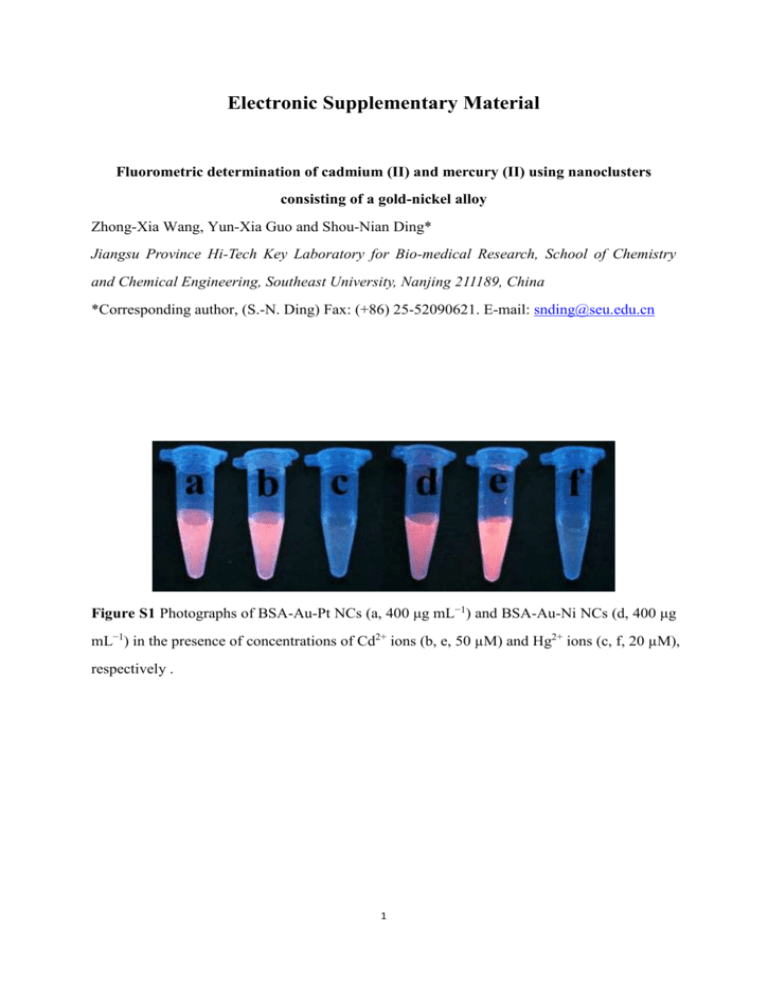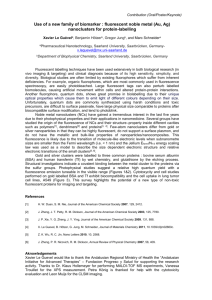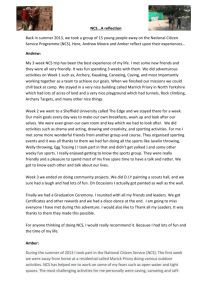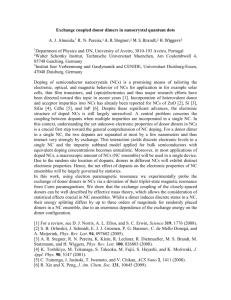Electronic Supplementary Material
advertisement

Electronic Supplementary Material Fluorometric determination of cadmium (II) and mercury (II) using nanoclusters consisting of a gold-nickel alloy Zhong-Xia Wang, Yun-Xia Guo and Shou-Nian Ding* Jiangsu Province Hi-Tech Key Laboratory for Bio-medical Research, School of Chemistry and Chemical Engineering, Southeast University, Nanjing 211189, China *Corresponding author, (S.-N. Ding) Fax: (+86) 25-52090621. E-mail: snding@seu.edu.cn Figure S1 Photographs of BSA-Au-Pt NCs (a, 400 μg mL−1) and BSA-Au-Ni NCs (d, 400 μg mL−1) in the presence of concentrations of Cd2+ ions (b, e, 50 µM) and Hg2+ ions (c, f, 20 µM), respectively . 1 Figure S2 TEM of the BSA-Au-Ni NCs. Inset: the diameter distribution of BSA-Au-Ni NCs. Figure S3 Fluorescence spectra of the BSA (a), BSA-Ni NCs (b), BSA-Au NCs (c) and BSA-Au-Ni NCs (d) at excitation wavelengths 340 nm, both the excitation and emission slit widths were 5 nm. 2 Figure S4 Photostability of the BSA-Au-Ni NCs as a function of the storage time, both the excitation and emission slit widths were 5 nm. Figure S5 The fluorescence intensity ratios (FL640nm/FL405nm) of BSA-Au-Ni NCs at 640 nm to that at 405 nm (excitation at 340 nm) at various pH values. 3 Figure S6 The fluorescence intensity ratios (FL640nm/FL405nm) of BSA-Au-Ni NCs at 640 nm to that at 405 nm (excitation at 340 nm) in the different concentration of NaCl solution. Figure S7 Fluorescence spectra of the BSA (a), BSA-Au-Ni NCs (b), and BSA-Cd(II) complex (c) at excitation wavelengths 340 nm, both the excitation and emission slit widths were 5 nm. The BSA concentration is 400.0 µg mL-1, and the concentration of Cd(II) in BSA-Cd(II) complex is 200 µM. 4 Table S1. Comparison of the linear range and detect limit for Cd2+ or Hg2+ ions different fluorescent probes Reference 1 Zhang, Y., Zhang, Z.L., Yin, D.H., Li, J., Xie, R.G., Yang, W.S. Turn-on Fluorescent InP Nanoprobe for Detection of Cadmium Ions with High Selectivity and Sensitivity. ACS Appl. Mater. Interfaces 2013. 5, 9709-9713. 2 Banerjee, S., Kara, S., Santra, S. A simple strategy for quantum dot assisted selective detection of cadmium ions. Chem. Commun. 2008. 3037-3039 3 Hua, X.Y., Zhu, K., Guo, Q.S., Liu, Y.Q., Ye, M.F., Sun, Q.J. Ligand displacement-induced fluorescence switch of quantum dots for ultrasensitive. Anal. Chim. Acta 2014. 812, 191-198. 4 Liu, J., Ren, X. G., Meng, X. W., Fang, Z., Tang, F. Q. Sensitive and selective detection of Hg2+and Cu2+ ions by fluorescent Ag nanoclusters synthesized via a hydrothermal method. Nanoscale 2013, 5, 10022-10028. 5 Huang, H., Lv, J. J., Zhou, D. L., Bao, N., Xu, Y., Wang, A. J., Feng, J. J. One-pot green synthesis of nitrogen-doped carbon nanoparticles as fluorescent probes for mercury ions. RSC Adv. 2013. 3, 21691-21696. 6 Wei, H., Wang, Z.D., Yang, L.M., Tian, S.L., Hou C.J., Lu, Y. Lysozyme-stabilized gold fluorescent cluster: Synthesis and application as Hg2+ sensor. Analyst 2010, 135, 1406-1410. 5











